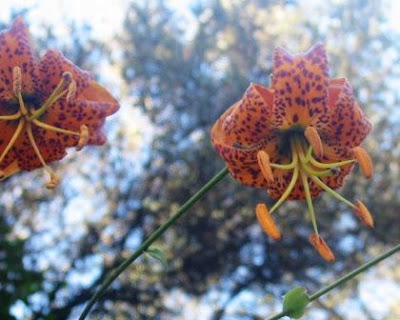 The other day a group of Topangans were talking together and we were trying to place where a certain family lived. My friend Anthea spoke up and said, "You know, it's that house on the boulevard just south of that big stand of Humboldt Lilies."
The other day a group of Topangans were talking together and we were trying to place where a certain family lived. My friend Anthea spoke up and said, "You know, it's that house on the boulevard just south of that big stand of Humboldt Lilies."My friend Anthea is a garden designer, so of course this is a landmark she would notice. But I knew what she meant. And most of the other people in the group nodded - they also recognized it.
 Humboldt Lilies are true lilies, native to California. "Lily" is a name English speakers tend to give to lots of big showy flowers, but true lilies, genus Lilium, are some 110 species of flowering plants that grow from bulbs. There are native lilies all over the world - Europe, Asia, and North America.
Humboldt Lilies are true lilies, native to California. "Lily" is a name English speakers tend to give to lots of big showy flowers, but true lilies, genus Lilium, are some 110 species of flowering plants that grow from bulbs. There are native lilies all over the world - Europe, Asia, and North America.
 The flowers are displayed in a scape at the top of the stem, a dozen or more blossoms. The and The Southern California subspecies is Lilium humboldtii subsp. ocellatum. Ocellated means having spots like little eyes, or oculi. Or like an Ocelot. Humboldt Lilies are orange with deeper brown or maroon spots.
The flowers are displayed in a scape at the top of the stem, a dozen or more blossoms. The and The Southern California subspecies is Lilium humboldtii subsp. ocellatum. Ocellated means having spots like little eyes, or oculi. Or like an Ocelot. Humboldt Lilies are orange with deeper brown or maroon spots.
Humboldt Lilies grow in mountain ranges, at elevations from 2000 to 3000 feet. They like good drainage and some shade. They bloom in June, and go dormant afterwards. Lilium pardalinum, Leopard or Panther lily, is a similar flower but grows in wetter soils by streams.
Humboldt Lilies are named after the European explorer and scientist Alexander von Humboldt. He was a contemporary of Napoleon, brother to the minister to the King of Prussia, and later served as diplomat for French King Louis Phillippe.
Humboldt was fascinated by bugs and other living things as a little boy, and also collected plants and shells. Although he was sent to school to study finance, he was interested in many things, and liked to travel. Soon he was joining scientific expeditions - first around Europe and finally in 1799 he joined an exploration of South America. He also explored Cuba, the United States south, and Russia.
His writings and essays were acclaimed, and he is said to have laid the foundation for the modern disciplines of geography and meteorology. He analyzed the magnetic properties of the Earth's poles, and studied volcanoes, theorizing about the igneous origin of certain rocks.

Humboldt Bay in Northern California was named by the sailors who discovered it. They were probably reading "Kosmos" on their long voyage around the Horn. His name was also given to a U.S. river, counties in three states, and four U.S. cities. There are at least a dozen plants and animals named after him.
Humboldt never married and had no children. Not much is known of his personal life, because he destroyed his private letters. He may have been gay, since he was known to have strong and emotional friendships with male colleagues throughout his life. He was a champion for the poor, an opponent of slavery, and his contribution to science is extraordinary. He died in 1859 at the age of 89.
One American political leader, Robert G. Ingersoll, said of Humboldt: "He was to science what Shakespeare is to the drama."


 They're in bloom now.
They're in bloom now.
9 comments:
Nine feet tall! Wow! Other than the sunflower, I've never seen a flower reach that high. Loved this post and learning about your native wildlife.
loved learning about the background of these beauties - they always look like Alice in Wonderland illustrations to me!
'Lily' is also what we call most old ladies!
Topanga Canyon Road...hmmm, that road sounds familiar to me. Does it run through Simi Valley as well? I lived there as a kid.
Beautiful flowers, and wonderful history lesson as well!
Glennis, these are absolutely breathtaking. I can only imagine with their size the beauty they impart.
The name Humboldt was familiar to my ears/eyes, but I don't' think I'd ever seen these beautiful lilies before. Thank you!
Beautiful, beautiful, beautiful. What a fascinating provenance for a wonderful plant, thanks.
Post a Comment